Related Research Articles

Boraginaceae, the borage or forget-me-notfamily, includes about 2,000 species of shrubs, trees, and herbs in 146 to 156 genera with a worldwide distribution.

Hieracium , known by the common name hawkweed and classically as hierakion, is a genus of flowering plant in the family Asteraceae, and closely related to dandelion (Taraxacum), chicory (Cichorium), prickly lettuce (Lactuca) and sow thistle (Sonchus), which are part of the tribe Cichorieae. Hawkweeds, with their 10,000+ recorded species and subspecies, do their part to make Asteraceae the second largest family of flowering plants. Some botanists group all these species or subspecies into approximately 800 accepted species, while others prefer to accept several thousand species. Since most hawkweeds reproduce exclusively asexually by means of seeds that are genetically identical to their mother plant, clones or populations that consist of genetically identical plants are formed and some botanists prefer to accept these clones as good species whereas others try to group them into a few hundred more broadly defined species. What is here treated as the single genus Hieracium is now treated by most European experts as two different genera, Hieracium and Pilosella, with species such as Hieracium pilosella, Hieracium floribundum and Hieracium aurantiacum referred to the latter genus. Many members of the genus Pilosella reproduce both by stolons and by seeds, whereas true Hieracium species reproduce only by seeds. In Pilosella, many individual plants are capable of forming both normal sexual and asexual (apomictic) seeds, whereas individual plants of Hieracium only produce one kind of seeds. Another difference is that all species of Pilosella have leaves with smooth (entire) margins whereas most species of Hieracium have distinctly dentate to deeply cut or divided leaves.
A dry roadside dotted with small, ¾ inch red orange flowers, interspersed with very similar yellow ones, and often the white of daisies, is a good sign that you are in Hawkweed country.

Pulmonaria (lungwort) is a genus of flowering plants in the family Boraginaceae, native to Europe and western Asia, with one species east to central Asia. According to various estimates there may be between 10 and 18 species found in the wild.
Cowslip may refer to:
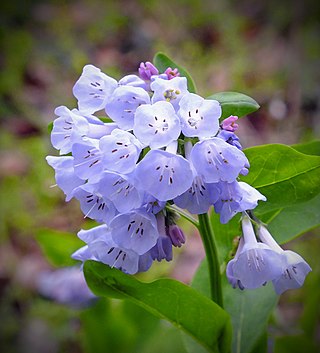
Mertensia is a genus of flowering plants in the family Boraginaceae. They are perennial herbaceous plants with blue or sometimes white flowers that open from pink-tinged buds. Such a change in flower color is common in Boraginaceae and is caused by an increase of pH in the flower tissue. Mertensia is one of several plants that are commonly called "bluebell". In spite of their common name, the flowers are usually salverform (trumpet-shaped) rather than campanulate (bell-shaped).

Mertensia virginica is a spring ephemeral plant in the Boraginaceae (borage) family with bell-shaped sky-blue flowers, native to eastern North America.

Pulmonaria officinalis, common names lungwort, common lungwort, Mary's tears or Our Lady's milk drops, is a herbaceous rhizomatous evergreen perennial plant of the genus Pulmonaria, belonging to the family Boraginaceae.

Lobaria pulmonaria is a large epiphytic lichen consisting of an ascomycete fungus and a green algal partner living together in a symbiotic relationship with a cyanobacterium—a symbiosis involving members of three kingdoms of organisms. Commonly known by various names like tree lungwort, lung lichen, lung moss, lungwort lichen, oak lungs or oak lungwort, it is sensitive to air pollution and is also harmed by habitat loss and changes in forestry practices. Its population has declined across Europe and L. pulmonaria is considered endangered in many lowland areas. The species has a history of use in herbal medicines, and recent research has corroborated some medicinal properties of lichen extracts.

Peltigerales is an order of lichen-forming fungi belonging to the class Lecanoromycetes in the division Ascomycota. The taxonomy of the group has seen numerous changes; it was formerly often treated as a suborder of the order Lecanorales. It contains two suborders, eight families and about 45 genera such as Lobaria and Peltigera.

Mertensia bella is a species of flowering plant in the borage family known by the common names beautiful bluebells and Oregon lungwort. It is native to the northwestern United States, where it grows in wet mountain habitat. It is a perennial herb producing a slender, erect stem and caudex unit up to half a meter tall. The rough-haired leaves are alternately arranged and borne on petioles. The inflorescence is an open array of clustered bright blue, bell-shaped flowers up to a centimeter wide at the lobed mouths.
Coleophora pennella is a moth of the family Coleophoridae. It is found in most of Europe.

Mertensia paniculata, also known as the tall lungwort, tall bluebells, or northern bluebells, is an herb or dwarf shrub with drooping, bright-blue, bell-shaped flowers. It is native to northwestern North America and the Great Lakes.
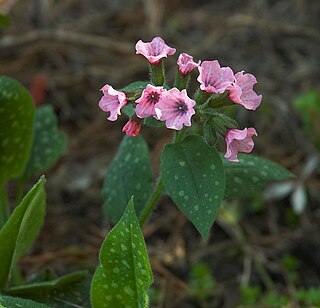
Pulmonaria saccharata, the Bethlehem lungwort or Bethlehem sage, is a species of flowering plant in the family Boraginaceae, native to France and Italy. It is a rhizomatous herbaceous perennial which is closely related to the common lungwort. Growing to 10 cm (4 in) tall by 60 cm (24 in) wide, it has lance-shaped leaves with white confluent spots, and pink or white flowers in spring.
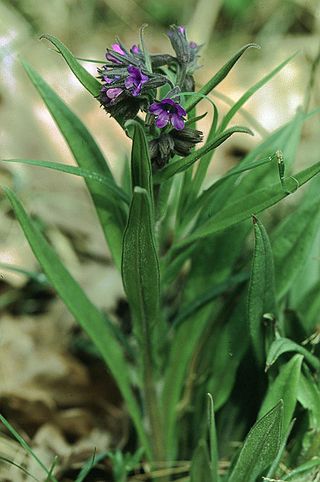
Pulmonaria angustifolia, the narrow-leaved lungwort or blue cowslip, is a species of flowering plant in the family Boraginaceae, native to central and north eastern Europe. Growing to 30 cm (12 in) tall by 45 cm (18 in) broad, it is an herbaceous perennial with hairy oval leaves and masses of bright blue flowers in spring. The subspecies azureus has brighter blue flowers.
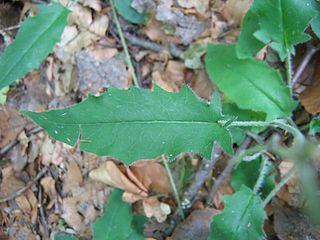
Hieracium murorum, the wall hawkweed, is a species of flowering plant in the family Asteraceae. It is native to Europe and naturalized in some of the colder regions of North America.
P. longifolia may refer to:
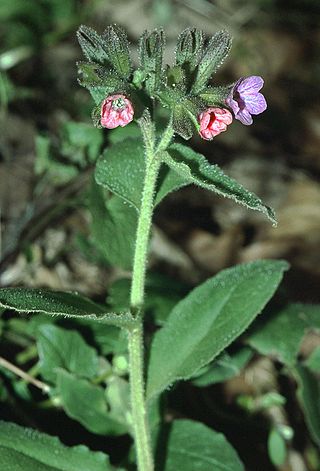
Pulmonaria obscura, common names unspotted lungwort or Suffolk lungwort, is a herbaceous evergreen perennial rhizomatous plant of the genus Pulmonaria, belonging to the family Boraginaceae. In Central Europe it is the most widely occurring member of the Boraginaceae.

Mertensia lanceolata, known as prairie bluebells, narrow-leaved languid lady, lance-leaved bluebells, and lance-leaved lungwort is a species of flowering plant native to western North America. A herbaceous perennial it has blue-green leaves alternately arranged on its smooth flowering stalk. Its flower buds are pink-purple and become more blue as they open. Accepted varieties include:
References
- ↑ "Wall hawkweed (Hieracium murorum)". Midwest Invasive Species Information Network. Retrieved 11 July 2023.